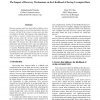Free Online Productivity Tools
i2Speak
i2Symbol
i2OCR
iTex2Img
iWeb2Print
iWeb2Shot
i2Type
iPdf2Split
iPdf2Merge
i2Bopomofo
i2Arabic
i2Style
i2Image
i2PDF
iLatex2Rtf
Sci2ools
ISSRE
2002
IEEE
2002
IEEE
The Impact of Recovery Mechanisms on the Likelihood of Saving Corrupted State
Recovery systems must save state before a failure occurs to enable the system to recover from the failure. However, recovery will fail if the recovery system saves any state corrupted by the fault. The frequency and comprehensiveness of how a recovery system saves state has a major effect on how often the recovery system inadvertently saves corrupted state. This paper explores and measures that effect. We measure how often software faults in the application and operating system cause real applications to save corrupted state when using different types of recovery systems. We find that generic recovery techniques, such as checkpointing and logging, work well for faults in the operating system. However, we find that they do not work well for faults in the application because the very actions taken to enable recovery often corrupt the state upon which successful recovery depends.
| Added | 15 Jul 2010 |
| Updated | 15 Jul 2010 |
| Type | Conference |
| Year | 2002 |
| Where | ISSRE |
| Authors | Subhachandra Chandra, Peter M. Chen |
Comments (0)

